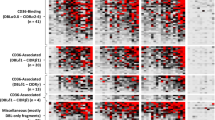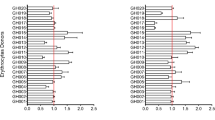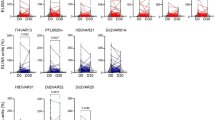Abstract
Haemoglobin C, which carries a glutamate-to-lysine mutation in the β-globin chain, protects West African children against Plasmodium falciparum malaria1,2. Mechanisms of protection are not established for the heterozygous (haemoglobin AC) or homozygous (haemoglobin CC) states. Here we report a marked effect of haemoglobin C on the cell-surface properties of P. falciparum-infected erythrocytes involved in pathogenesis. Relative to parasite-infected normal erythrocytes (haemoglobin AA), parasitized AC and CC erythrocytes show reduced adhesion to endothelial monolayers expressing CD36 and intercellular adhesion molecule-1 (ICAM-1). They also show impaired rosetting interactions with non-parasitized erythrocytes, and reduced agglutination in the presence of pooled sera from malaria-immune adults. Abnormal cell-surface display of the main variable cytoadherence ligand, PfEMP-1 (P. falciparum erythrocyte membrane protein-1), correlates with these findings. The abnormalities in PfEMP-1 display are associated with markers of erythrocyte senescence, and are greater in CC than in AC erythrocytes. Haemoglobin C might protect against malaria by reducing PfEMP-1-mediated adherence of parasitized erythrocytes, thereby mitigating the effects of their sequestration in the microvasculature.
This is a preview of subscription content, access via your institution
Access options
Subscribe to this journal
Receive 51 print issues and online access
$199.00 per year
only $3.90 per issue
Buy this article
- Purchase on SpringerLink
- Instant access to full article PDF
Prices may be subject to local taxes which are calculated during checkout




Similar content being viewed by others

References
Agarwal, A. et al. Hemoglobin C associated with protection from severe malaria in the Dogon of Mali, a West African population with a low prevalence of hemoglobin S. Blood 96, 2358–2363 (2000)
Modiano, D. et al. Haemoglobin C protects against clinical Plasmodium falciparum malaria. Nature 414, 305–308 (2001)
Flint, J., Harding, R. M., Boyce, A. J. & Clegg, J. B. The population genetics of the haemoglobinopathies. Baillieres Clin. Haematol. 11, 1–51 (1998)
Allison, A. C. Genetic factors in resistance to malaria. Ann. NY Acad. Sci. 91, 710–729 (1961)
Friedman, M. J., Roth, E. F., Nagel, R. L. & Trager, W. The role of hemoglobins C, S, and Nbalt in the inhibition of malaria parasite development in vitro. Am. J. Trop. Med. Hyg. 28, 777–780 (1979)
Fairhurst, R. M., Fujioka, H., Hayton, K., Collins, K. F. & Wellems, T. E. Aberrant development of Plasmodium falciparum in hemoglobin CC red cells: implications for the malaria protective effect of the homozygous state. Blood 101, 3309–3315 (2003)
Miller, L. H., Baruch, D. I., Marsh, K. & Doumbo, O. K. The pathogenic basis of malaria. Nature 415, 673–679 (2002)
Baruch, D. I. et al. Cloning the P. falciparum gene encoding PfEMP1, a malarial variant antigen and adherence receptor on the surface of parasitized human erythrocytes. Cell 82, 77–87 (1995)
Rowe, J. A., Moulds, J. M., Newbold, C. I. & Miller, L. H. P. falciparum rosetting mediated by a parasite-variant erythrocyte membrane protein and complement-receptor 1. Nature 388, 292–295 (1997)
Yipp, B. G. et al. Synergism of multiple adhesion molecules in mediating cytoadherence of Plasmodium falciparum-infected erythrocytes to microvascular endothelial cells under flow. Blood 96, 2292–2298 (2000)
Rowe, A., Obeiro, J., Newbold, C. I. & Marsh, K. Plasmodium falciparum rosetting is associated with malaria severity in Kenya. Infect. Immun. 63, 2323–2326 (1995)
Marsh, K., Otoo, L., Hayes, R. J., Carson, D. C. & Greenwood, B. M. Antibodies to blood stage antigens of Plasmodium falciparum in rural Gambians and their relation to protection against infection. Trans. R. Soc. Trop. Med. Hyg. 83, 293–303 (1989)
Bull, P. C. et al. Parasite antigens on the infected red cell surface are targets for naturally acquired immunity to malaria. Nature Med. 4, 358–360 (1998)
Crabb, B. S. et al. Targeted gene disruption shows that knobs enable malaria-infected red cells to cytoadhere under physiological shear stress. Cell 89, 287–296 (1997)
Oh, S. S. et al. Plasmodium falciparum erythrocyte membrane protein 1 is anchored to the actin-spectrin junction and knob-associated histidine-rich protein in the erythrocyte skeleton. Mol. Biochem. Parasitol. 108, 237–247 (2000)
Arie, T., Fairhurst, R. M., Brittain, N. J., Wellems, T. E. & Dvorak, J. A. Hemoglobin C modulates the surface topology of Plasmodium falciparum-infected erythrocytes. J. Struct. Biol. 150, 163–169 (2005)
Williams, A. R. & Morris, D. R. The internal viscosity of the human erythrocyte may determine its lifespan in vivo. Scand. J. Haematol. 24, 57–62 (1980)
Huisman, T. H. Chromatographic separation of hemoglobins A 2 and C. The quantities of hemoglobin A 2 in patients with AC trait, CC disease, and C-β-thalassemia. Clin. Chim. Acta 40, 159–163 (1972)
Bunn, H. F. et al. Molecular and cellular pathogenesis of hemoglobin SC disease. Proc. Natl Acad. Sci. USA 79, 7527–7531 (1982)
Charache, S., Conley, C. L., Waugh, D. F., Ugoretz, R. J. & Spurrell, J. R. Pathogenesis of hemolytic anemia in homozygous hemoglobin C disease. J. Clin. Invest. 46, 1795–1811 (1967)
Murphy, J. R. Influence of temperature and method of centrifugation on the separation of erythrocytes. J. Lab. Clin. Med. 82, 334–341 (1973)
Low, P. S., Waugh, S. M., Zinke, K. & Drenckhahn, D. The role of hemoglobin denaturation and band 3 clustering in red blood cell aging. Science 227, 531–533 (1985)
MacDonald, V. W. & Charache, S. Drug-induced oxidation and precipitation of hemoglobins A, S and C. Biochim. Biophys. Acta 701, 39–44 (1982)
Kaul, D. K., Roth, E. F. Jr, Nagel, R. L., Howard, R. J. & Handunnetti, S. M. Rosetting of Plasmodium falciparum-infected red blood cells with uninfected red blood cells enhances microvascular obstruction under flow conditions. Blood 78, 812–819 (1991)
MacPherson, G. G., Warrell, M. J., White, N. J., Looareesuwan, S. & Warrell, D. A. Human cerebral malaria. A quantitative ultrastructural analysis of parasitized erythrocyte sequestration. Am. J. Pathol. 119, 385–401 (1985)
Ricke, C. H. et al. Plasma antibodies from malaria-exposed pregnant women recognize variant surface antigens on Plasmodium falciparum-infected erythrocytes in a parity-dependent manner and block parasite adhesion to chondroitin sulfate A. J. Immunol. 165, 3309–3316 (2000)
Ruwende, C. et al. Natural selection of hemi- and heterozygotes for G6PD deficiency in Africa by resistance to severe malaria. Nature 376, 246–249 (1995)
Gamain, B. et al. The surface variant antigens of Plasmodium falciparum contain cross-reactive epitopes. Proc. Natl Acad. Sci. USA 98, 2664–2669 (2001)
Giribaldi, G., Ulliers, D., Mannu, F., Arese, P. & Turrini, F. Growth of Plasmodium falciparum induces stage-dependent haemichrome formation, oxidative aggregation of band 3, membrane deposition of complement and antibodies, and phagocytosis of parasitized erythrocytes. Br. J. Haematol. 113, 492–499 (2001)
Winterbourne, C. C. in CRC Handbook of Methods of Oxygen Radical Research (ed. Greenwald, R. A.) 137–141 (CRC Press, Boca Raton, 1985)
Acknowledgements
We thank our blood donors and J. F. Casella, B. Link, G. Rodgers, M. Law, K. D. Luc, N. Murray, J. A. Dvorak, F. Tokumasu, T. Arie, E. Fischer, L. H. Miller, A. Sadou, A. Katilé, B. Dakouo, K. Traoré and S. A. S. Diakité for their efforts in support of this work. H. F. acknowledges support from the United States Agency for International Development and the National Institutes of Health.
Author information
Authors and Affiliations
Corresponding author
Ethics declarations
Competing interests
Reprints and permissions information is available at npg.nature.com/reprintsandpermissions. The authors declare no competing financial interests.
Supplementary information
Supplementary Table S1
Median fluorescence intensities of parasitized erythrocyte populations probed with rat antisera. (DOC 78 kb)
Supplementary Table S2
Data demonstrating synchrony of the GB4 and 7G8 parasite lines in simultaneously infected AA and CC erythrocytes. (DOC 47 kb)
Rights and permissions
About this article
Cite this article
Fairhurst, R., Baruch, D., Brittain, N. et al. Abnormal display of PfEMP-1 on erythrocytes carrying haemoglobin C may protect against malaria. Nature 435, 1117–1121 (2005). https://doi.org/10.1038/nature03631
Received:
Accepted:
Issue date:
DOI: https://doi.org/10.1038/nature03631
This article is cited by
-
Effect of iron fortification on anaemia and risk of malaria among Ghanaian pre-school children with haemoglobinopathies and different ABO blood groups
BMC Nutrition (2023)
-
Single-molecule imaging and quantification of the immune-variant adhesin VAR2CSA on knobs of Plasmodium falciparum-infected erythrocytes
Communications Biology (2019)
-
Hemoglobin S and C affect biomechanical membrane properties of P. falciparum-infected erythrocytes
Communications Biology (2019)
-
Hemoglobin variants shape the distribution of malaria parasites in human populations and their transmission potential
Scientific Reports (2017)
-
Heterozygous HbAC but not HbAS is associated with higher newborn birthweight among women with pregnancy-associated malaria
Scientific Reports (2017)


